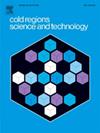Micromechanics-based strength criterion for tailings silty clay considering the influence of freeze-thaw cycles
IF 3.8
2区 工程技术
Q1 ENGINEERING, CIVIL
引用次数: 0
Abstract
Based on triaxial compression test results and scanning electron microscopy (SEM) analysis of tailings silty clay subjected to different freeze-thaw cycles, a new strength criterion is proposed that accounts for the influence of bonding structure, particle arrangement, and pore distribution. The changes in strength of tailings powdery clay under different freeze-thaw cycles (0, 1, 5, 10, and 15) were studied by examining the changes in microporous structure and strength curves obtained from triaxial tests. In formulating the strength criterion, tailings soil is modeled as a binary-material system consisting of bonding elements (matrix) and frictional elements (inclusion). The bonding elements are characterized by the Mohr-Coulomb strength criterion, while the frictional elements are described by the Drucker-Prager strength criterion. Microscopic strength data are derived from the material dissipation function. The differences between the dissipation function and elastic strain energy are used to reveal the material's nonlinear behavior. By incorporating freeze-thaw cycle parameters into the volume fraction of frictional elements, strain energy expressions are constructed using the homogenization method. This allows for the determination of the macroscopic dissipation function of the composite material, which leads to the derivation of a strength criterion for two-phase linear cemented- frictional composite materials under freeze-thaw cycle conditions. The effectiveness of the proposed criterion was validated using triaxial test data. The results demonstrate that the criterion accurately predicts the strength characteristics of tailings silty clay under freeze-thaw cycles. However, it should be noted that the proposed model has certain limitations. Its performance under extreme conditions requires further research.
考虑冻融循环影响的尾矿粉质粘土细观力学强度准则
基于不同冻融循环下尾矿粉质粘土的三轴压缩试验结果和扫描电镜(SEM)分析,提出了考虑黏结结构、颗粒排列和孔隙分布影响的新型强度准则。通过三轴试验获得的微孔结构变化和强度曲线,研究了不同冻融循环(0、1、5、10和15)条件下尾矿粉状粘土的强度变化。在制定强度准则时,将尾矿库土建模为由粘结单元(基体)和摩擦单元(包体)组成的二元材料体系。结合单元采用Mohr-Coulomb强度准则,摩擦单元采用Drucker-Prager强度准则。微观强度数据由材料耗散函数导出。利用耗散函数和弹性应变能之间的差异来揭示材料的非线性行为。将冻融循环参数与摩擦单元的体积分数相结合,采用均质化方法建立了应变能表达式。这可以确定复合材料的宏观耗散函数,从而推导出冻融循环条件下两相线性胶结摩擦复合材料的强度准则。利用三轴试验数据验证了该准则的有效性。结果表明,该准则准确地预测了尾矿粉质粘土在冻融循环作用下的强度特性。然而,应该指出的是,所提出的模型有一定的局限性。它在极端条件下的性能需要进一步研究。
本文章由计算机程序翻译,如有差异,请以英文原文为准。
求助全文
约1分钟内获得全文
求助全文
来源期刊

Cold Regions Science and Technology
工程技术-地球科学综合
CiteScore
7.40
自引率
12.20%
发文量
209
审稿时长
4.9 months
期刊介绍:
Cold Regions Science and Technology is an international journal dealing with the science and technical problems of cold environments in both the polar regions and more temperate locations. It includes fundamental aspects of cryospheric sciences which have applications for cold regions problems as well as engineering topics which relate to the cryosphere.
Emphasis is given to applied science with broad coverage of the physical and mechanical aspects of ice (including glaciers and sea ice), snow and snow avalanches, ice-water systems, ice-bonded soils and permafrost.
Relevant aspects of Earth science, materials science, offshore and river ice engineering are also of primary interest. These include icing of ships and structures as well as trafficability in cold environments. Technological advances for cold regions in research, development, and engineering practice are relevant to the journal. Theoretical papers must include a detailed discussion of the potential application of the theory to address cold regions problems. The journal serves a wide range of specialists, providing a medium for interdisciplinary communication and a convenient source of reference.
 求助内容:
求助内容: 应助结果提醒方式:
应助结果提醒方式:


